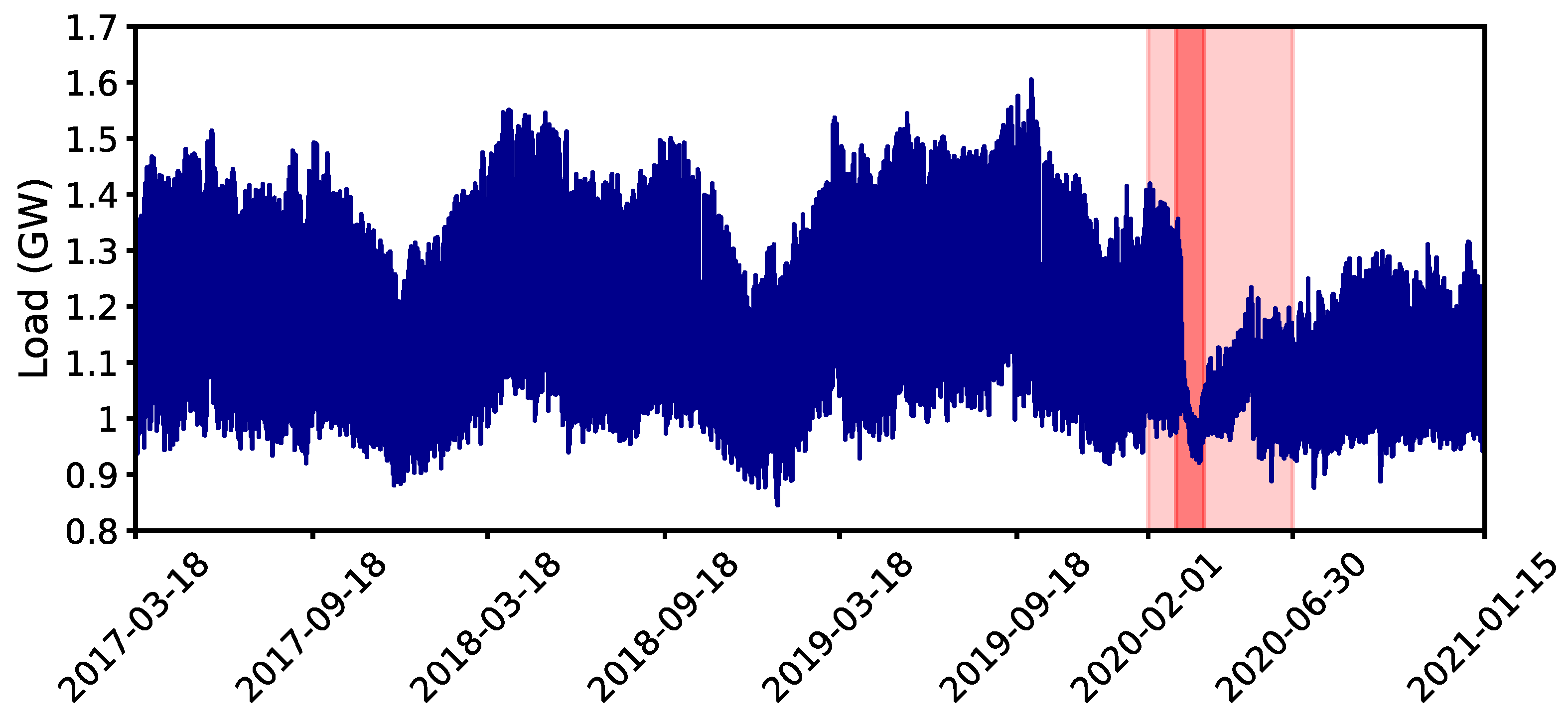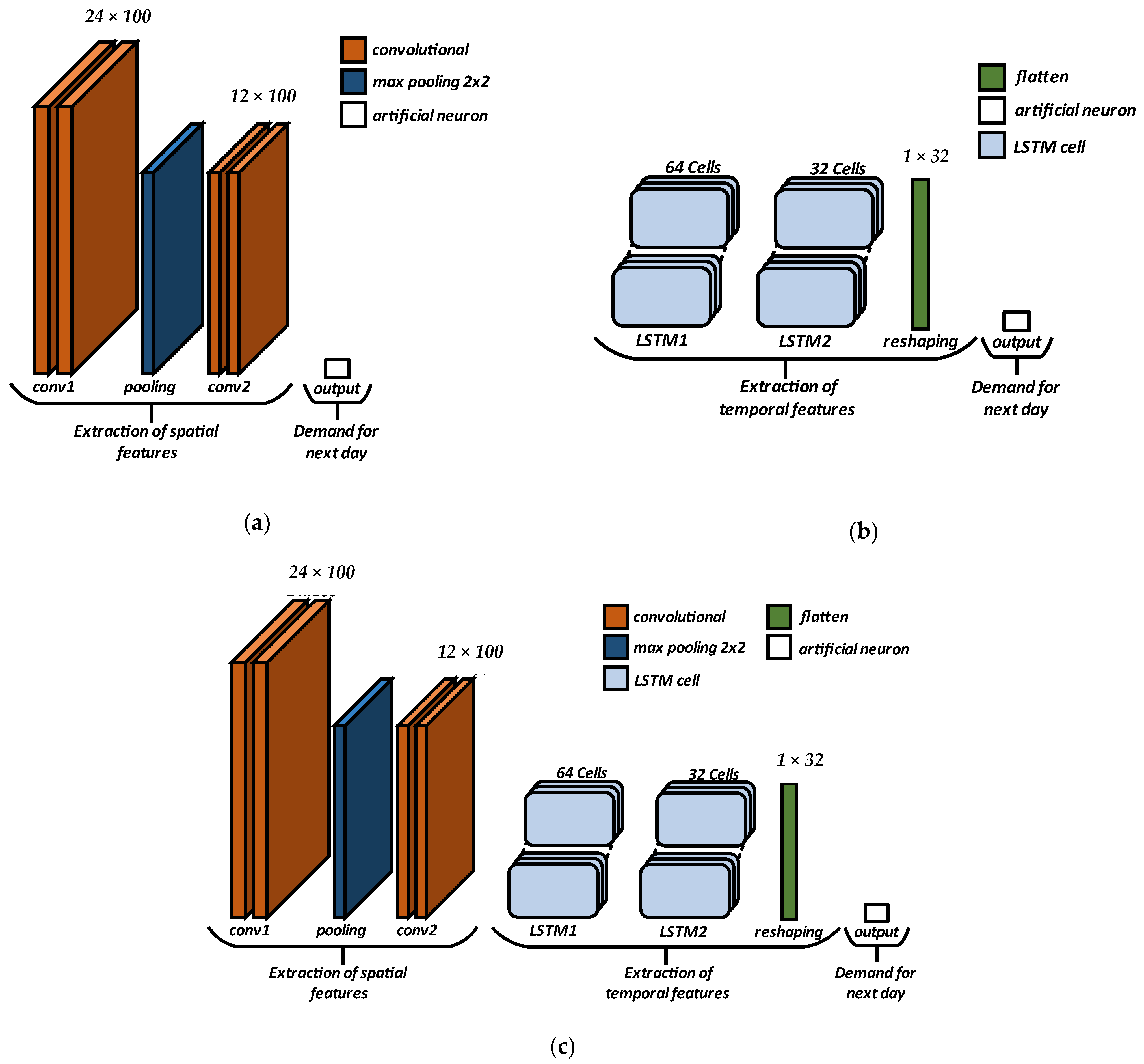A Hybrid Deep Neural Network Architecture for Day-Ahead Electricity Forecasting: Post-COVID Paradigm
Abstract
1. Introduction
- Proposal of predictive models based on deep learning, with spatial-temporal dependence, considering lockdown periods established during the COVID-19 pandemic for demand prediction, using the same database as the IEEE competition previously mentioned;
- To preliminarily investigate the input variables, proposing methods for selecting and rescaling such variables before the model training stage and applying the same testing and validation procedures previously determined by the IEEE competition;
- Comparing the proposed deep learning model with the best performance with the previously mentioned models developed in the IEEE competition, employing the same metrics for performance analysis.
2. Literature Review
3. Methodology
3.1. Materials
3.2. Preprocessing
3.3. Deep Neural Network Architectures
3.4. Evaluation Metrics
3.5. Simulation Environment
4. Results
5. Discussion
6. Conclusions
Author Contributions
Funding
Data Availability Statement
Conflicts of Interest
References
- Nti, I.K.; Teimeh, M.; Nyarko-Boateng, O.; Adekoya, A.F. Electricity load forecasting: A systematic review. J. Electr. Syst. Inf. Technol. 2020, 7, 13. [Google Scholar] [CrossRef]
- Raza, M.Q.; Khosravi, A. A review on artificial intelligence based load demand forecasting techniques for smart grid and buildings. Renew. Sustain. Energy Rev. 2015, 50, 1352–1372. [Google Scholar] [CrossRef]
- Verwiebe, P.A.; Seim, S.; Burges, S.; Schulz, L.; Müller-Kirchenbauer, J. Modeling Energy Demand—A Systematic Literature Review. Energies 2021, 14, 7859. [Google Scholar] [CrossRef]
- Salleh, N.S.M.; Suliman, A.; Jorgensen, B.N. A Systematic Literature Review of Machine Learning Methods for Short-Term Electricity Forecasting. In Proceedings of the 2020 8th International Conference on Information Technology and Multimedia (ICIMU), Selangor, Malaysia, 24–26 August 2020; Institute of Electrical and Electronics Engineers, Inc.: New York, NY, USA, 2020; pp. 409–414. [Google Scholar] [CrossRef]
- Román-Portabales, A.; López-Nores, M.; Pazos-Arias, J.J. Systematic Review of Electricity Demand Forecast Using ANN-Based Machine Learning Algorithms. Sensors 2021, 21, 4544. [Google Scholar] [CrossRef]
- Agdas, D.; Barooah, P. Impact of the COVID-19 Pandemic on the U.S. Electricity Demand and Supply: An Early View from Data. IEEE Access 2020, 8, 151523–151534. [Google Scholar] [CrossRef]
- Siksnelyte-Butkiene, I. Impact of the COVID-19 Pandemic to the Sustainability of the Energy Sector. Sustainability 2021, 13, 12973. [Google Scholar] [CrossRef]
- Alhajeri, H.M.; Almutairi, A.; Alenezi, A.; Alshammari, F. Energy Demand in the State of Kuwait During the Covid-19 Pandemic: Technical, Economic, and Environmental Perspectives. Energies 2020, 13, 4370. [Google Scholar] [CrossRef]
- Zhang, L.; Li, H.; Lee, W.-J.; Liao, H. COVID-19 and energy: Influence mechanisms and research methodologies. Sustain. Prod. Consum. 2021, 27, 2134–2152. [Google Scholar] [CrossRef] [PubMed]
- Ghiani, E.; Galici, M.; Mureddu, M.; Pilo, F. Impact on Electricity Consumption and Market Pricing of Energy and Ancillary Services during Pandemic of COVID-19 in Italy. Energies 2020, 13, 3357. [Google Scholar] [CrossRef]
- Navon, A.; Machlev, R.; Carmon, D.; Onile, A.E.; Belikov, J.; Levron, Y. Effects of the COVID-19 Pandemic on Energy Systems and Electric Power Grids—A Review of the Challenges Ahead. Energies 2021, 14, 1056. [Google Scholar] [CrossRef]
- Obst, D.; de Vilmarest, J.; Goude, Y. Adaptive Methods for Short-Term Electricity Load Forecasting During COVID-19 Lockdown in France. IEEE Trans. Power Syst. 2021, 36, 4754–4763. [Google Scholar] [CrossRef] [PubMed]
- Tudose, A.M.; Picioroaga, I.I.; Sidea, D.O.; Bulac, C.; Boicea, V.A. Short-Term Load Forecasting Using Convolutional Neural Networks in COVID-19 Context: The Romanian Case Study. Energies 2021, 14, 4046. [Google Scholar] [CrossRef]
- Lu, H.; Ma, X.; Ma, M. A hybrid multi-objective optimizer-based model for daily electricity demand prediction considering COVID-19. Energy 2020, 219, 119568. [Google Scholar] [CrossRef] [PubMed]
- Farrokhabadi, M.; Browell, J.; Wang, Y.; Makonin, S.; Su, W.; Zareipour, H. Day-Ahead Electricity Demand Forecasting Competition: Post-COVID Paradigm. IEEE Open Access J. Power Energy 2022, 9, 185–191. [Google Scholar] [CrossRef]
- De Vilmarest, J.; Goude, Y. State-Space Models for Online Post-Covid Electricity Load Forecasting Competition. IEEE Open Access J. Power Energy 2022, 9, 192–201. [Google Scholar] [CrossRef]
- Ziel, F. Smoothed Bernstein Online Aggregation for Short-Term Load Forecasting in IEEE DataPort Competition on Day-Ahead Electricity Demand Forecasting: Post-COVID Paradigm. IEEE Open Access J. Power Energy 2022, 9, 202–212. [Google Scholar] [CrossRef]
- Al-Saudi, K.; Degeler, V.; Medema, M. Energy Consumption Patterns and Load Forecasting with Profiled CNN-LSTM Networks. Processes 2021, 9, 1870. [Google Scholar] [CrossRef]
- Le, T.; Vo, M.T.; Vo, B.; Hwang, E.; Rho, S.; Baik, S.W. Improving Electric Energy Consumption Prediction Using CNN and Bi-LSTM. Appl. Sci. 2019, 9, 4237. [Google Scholar] [CrossRef]
- Peng, J.; Kimmig, A.; Niu, Z.; Wang, J.; Liu, X.; Ovtcharova, J. A flexible potential-flow model based high resolution spatiotemporal energy demand forecasting framework. Appl. Energy 2021, 299, 117321. [Google Scholar] [CrossRef]
- Zhu, K.; Geng, J.; Wang, K. A hybrid prediction model based on pattern sequence-based matching method and extreme gradient boosting for holiday load forecasting. Electr. Power Syst. Res. 2021, 190, 106841. [Google Scholar] [CrossRef]
- Hafeez, G.; Alimgeer, K.S.; Wadud, Z.; Shafiq, Z.; Khan, M.U.A.; Khan, I.; Khan, F.A.; Derhab, A. A Novel Accurate and Fast Converging Deep Learning-Based Model for Electrical Energy Consumption Forecasting in a Smart Grid. Energies 2020, 13, 2244. [Google Scholar] [CrossRef]
- Barman, M.; Choudhury, N.B.D. A similarity based hybrid GWO-SVM method of power system load forecasting for regional special event days in anomalous load situations in Assam, India. Sustain. Cities Soc. 2020, 61, 102311. [Google Scholar] [CrossRef]
- Yu, C.-N.; Mirowski, P.; Ho, T.K. A Sparse Coding Approach to Household Electricity Demand Forecasting in Smart Grids. IEEE Trans. Smart Grid 2017, 8, 738–748. [Google Scholar] [CrossRef]
- Ayub, N.; Irfan, M.; Awais, M.; Ali, U.; Ali, T.; Hamdi, M.; Alghamdi, A.; Muhammad, F. Big Data Analytics for Short and Medium-Term Electricity Load Forecasting Using an AI Techniques Ensembler. Energies 2020, 13, 5193. [Google Scholar] [CrossRef]
- Bedi, J.; Toshniwal, D. Empirical Mode Decomposition Based Deep Learning for Electricity Demand Forecasting. IEEE Access 2018, 6, 49144–49156. [Google Scholar] [CrossRef]
- Senjyu, T.; Takara, H.; Uezato, K.; Funabashi, T. One-hour-ahead load forecasting using neural network. IEEE Trans. Power Syst. 2002, 17, 113–118. [Google Scholar] [CrossRef]
- Jiang, Q.; Cheng, Y.; Le, H.; Li, C.; Liu, P.X. A Stacking Learning Model Based on Multiple Similar Days for Short-Term Load Forecasting. Mathematics 2022, 10, 2446. [Google Scholar] [CrossRef]
- Huang, L.; Liao, Q.; Qiu, R.; Liang, Y.; Long, Y. Prediction-based analysis on power consumption gap under long-term emergency: A case in China under COVID-19. Appl. Energy 2021, 283, 116339. [Google Scholar] [CrossRef] [PubMed]
- Alasali, F.; Nusair, K.; Alhmoud, L.; Zarour, E. Impact of the COVID-19 Pandemic on Electricity Demand and Load Forecasting. Sustainability 2021, 13, 1435. [Google Scholar] [CrossRef]
- Özbay, H.; Dalcali, A. Effects of COVID-19 on electric energy consumption in Turkey and ANN-based short-term forecasting. Turk. J. Electr. Eng. Comput. Sci. 2021, 29, 78–97. [Google Scholar] [CrossRef]
- Scarabaggio, P.; La Scala, M.; Carli, R.; Dotoli, M. Analyzing the Effects of COVID-19 Pandemic on the Energy Demand: The Case of Northern Italy. In Proceedings of the 12th AEIT International Annual Conference (AEIT), Catania, Italy, 23–25 September 2020; Institute of Electrical and Electronics Engineers, Inc.: New York, NY, USA, 2020. [Google Scholar] [CrossRef]
- Mohammad, F.; Ahmed, M.A.; Kim, Y.-C. Efficient Energy Management Based on Convolutional Long Short-Term Memory Network for Smart Power Distribution System. Energies 2021, 14, 6161. [Google Scholar] [CrossRef]






| Refs. | Rank | Preprocessing | Method | Result MAE (KW) |
|---|---|---|---|---|
| [16] | 1 | Application of a linear forecasting model on weather forecast errors and temperature smoothing with a factor of 0.95 and 0.99. | Ensemble of models: Auto-regression, linear regression, generalized additive models, random forest, random forest for GAM residuals, multi-layer perceptron, and Kalman filter adaptation. | 10,844 |
| [15] | 2 | Demand normalization per daily peak | Matching of similar days by day type and peak temperature. Adjustment based on recent peak load forecast patterns of days of the same type. | 11,849 |
| [17] | 3 | Training adjusted for holiday days. Definition of cardinal wind components, daily weather features, multiple ReLU transformations. Visual detection of outliers, filled in with interpolation. | Ensemble of models: STL-decomposed exponential smoothing, AR(p), generalized additive models, and lasso-estimated high-dimensional linear models. Defining models for each runtime. Combination by Bernstein’s smoothed online aggregation. | 11,890 |
| [15] | 4 | Data normalization between 0–1 | Ensemble of models: random forest, gradient boosted machine, and XGBoost. Weighted average combination based on recent performance. | 12,280 |
| [15] | 5 | None | Residual deep networks | 12,317 |
| [15] | 6 | Information not available | Information not available | 13,947 |
| [15] | 7 | Information not available | Information not available | 14,203 |
| [15] | 8 | Sin/Cos of hour of day and day of year, averages of recent demand, averages of recent weather forecast error | Regression tree with gradient increase and quantile loss. Different models for periods 0–8 h and 9–24 h. Fitting using grid search. | 14,263 |
| [15] | 9 | None | The same-day demand for the last three weeks is averaged and multiplied by 1.02. | 14,579 |
| [15] | 22 | None | Ensemble models based on the Facebook prophet to forecast temperature, cloud cover, and demand. XGBoost to predict temperature and load using prophet predictions as input. Models and forecasts are combined using simple linear regression. | 17,432 |
| Variable | Unit | Type |
|---|---|---|
| Demand | kW | Actual value |
| Air pressure | kPa | Actual value and forecast value |
| Cloud cover | % | Actual value and forecast value |
| Humidity | % | Actual value |
| Temperature | °C | Actual value and forecast value |
| Wind direction | grade | Actual value and forecast value |
| Wind velocity | km/h | Actual value and forecast value |
| Time | Year-Month-Day/HH-MM-SS | Actual value |
| Architecture | Method | MAE (kW) |
|---|---|---|
| #1 | CNN | 93,968.08 |
| #2 | LSTM | 2530.15 |
| #3 | CNN + LSTM | 2361.84 |
| Rank | Method | MAE (kW) |
|---|---|---|
| 1 [16] | Multi-model machine learning ensemble (72 models) | 10,844 |
| 2 [15] | Matching similar days by day types and peak temperature | 11,849 |
| 3 [17] | Multi-model machine learning ensemble (674 models) | 11,890 |
| Proposed method | Hybrid model (CNN+LSTM) | 2361 |
Disclaimer/Publisher’s Note: The statements, opinions and data contained in all publications are solely those of the individual author(s) and contributor(s) and not of MDPI and/or the editor(s). MDPI and/or the editor(s) disclaim responsibility for any injury to people or property resulting from any ideas, methods, instructions or products referred to in the content. |
© 2023 by the authors. Licensee MDPI, Basel, Switzerland. This article is an open access article distributed under the terms and conditions of the Creative Commons Attribution (CC BY) license (https://creativecommons.org/licenses/by/4.0/).
Share and Cite
Vilaça, N.L.; Costa, M.G.F.; Costa Filho, C.F.F. A Hybrid Deep Neural Network Architecture for Day-Ahead Electricity Forecasting: Post-COVID Paradigm. Energies 2023, 16, 3546. https://doi.org/10.3390/en16083546
Vilaça NL, Costa MGF, Costa Filho CFF. A Hybrid Deep Neural Network Architecture for Day-Ahead Electricity Forecasting: Post-COVID Paradigm. Energies. 2023; 16(8):3546. https://doi.org/10.3390/en16083546
Chicago/Turabian StyleVilaça, Neilson Luniere, Marly Guimarães Fernandes Costa, and Cicero Ferreira Fernandes Costa Filho. 2023. "A Hybrid Deep Neural Network Architecture for Day-Ahead Electricity Forecasting: Post-COVID Paradigm" Energies 16, no. 8: 3546. https://doi.org/10.3390/en16083546
APA StyleVilaça, N. L., Costa, M. G. F., & Costa Filho, C. F. F. (2023). A Hybrid Deep Neural Network Architecture for Day-Ahead Electricity Forecasting: Post-COVID Paradigm. Energies, 16(8), 3546. https://doi.org/10.3390/en16083546








